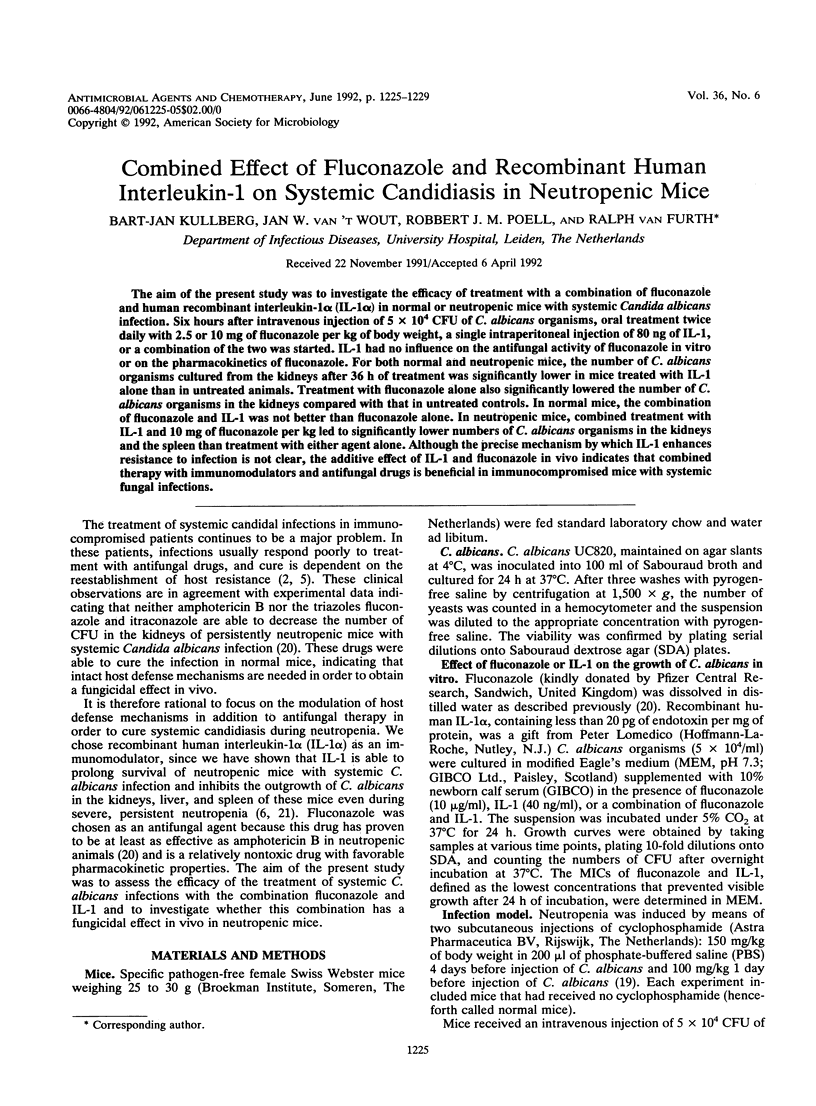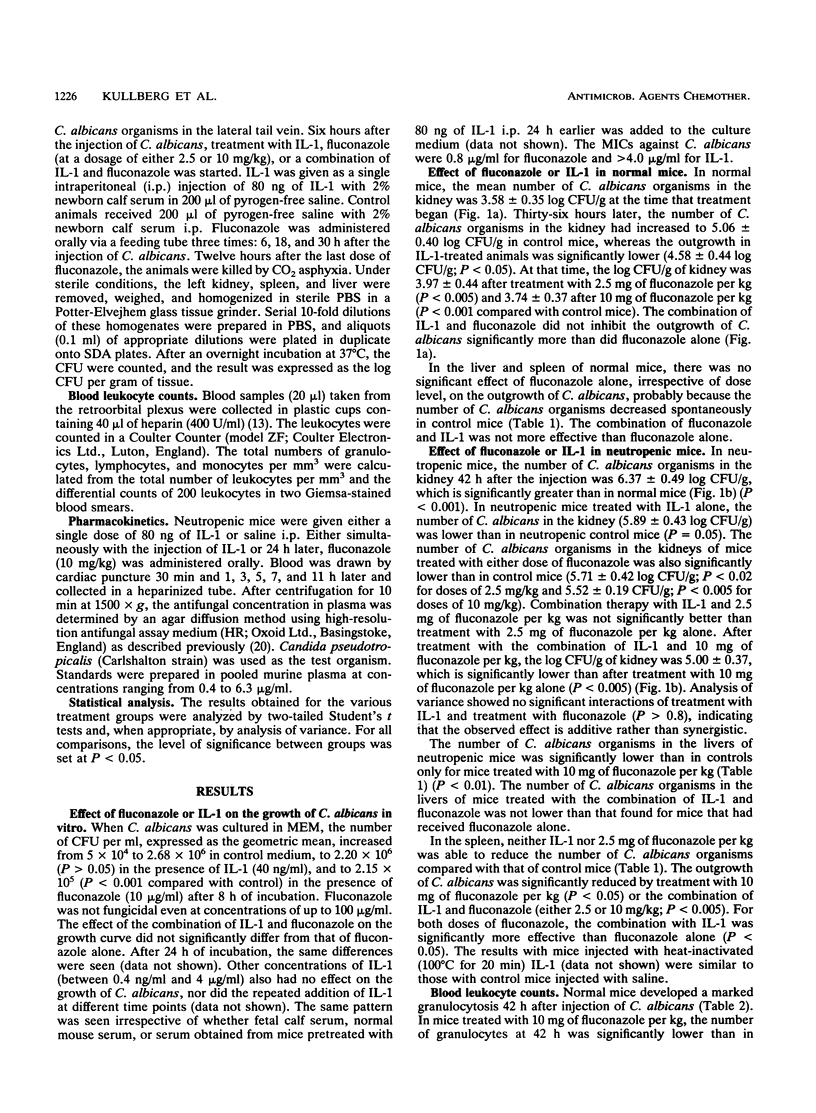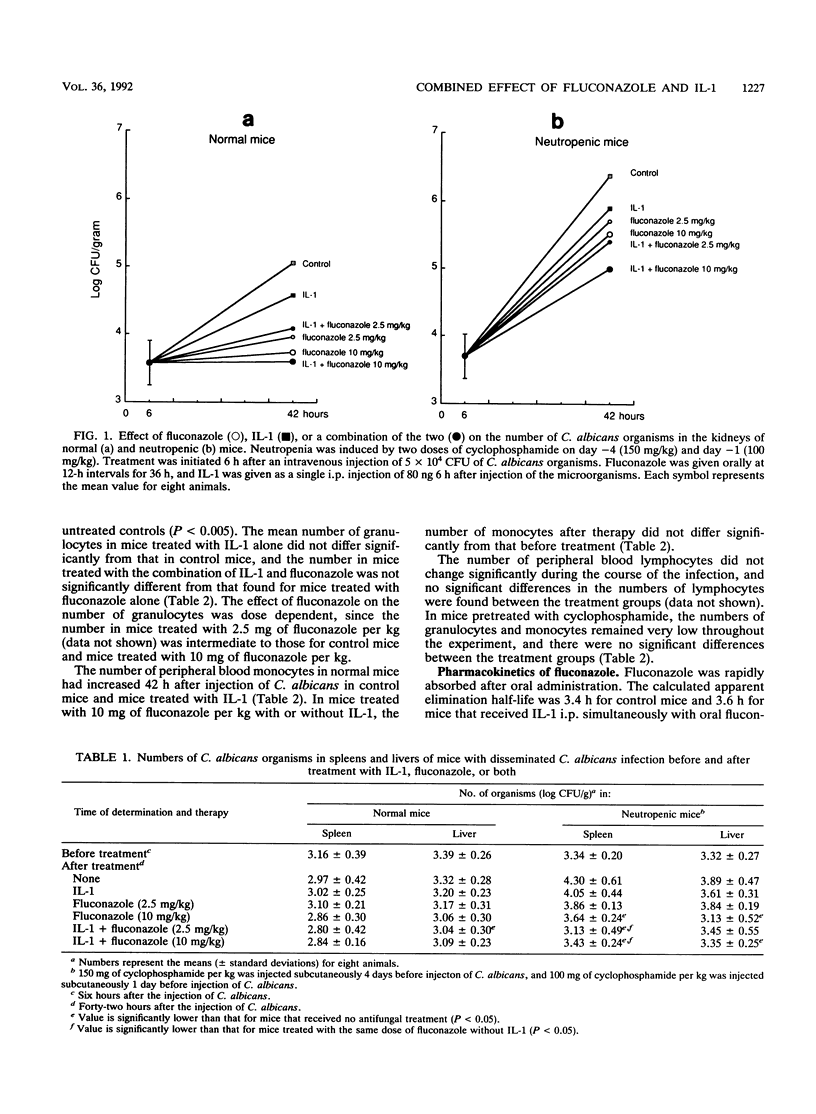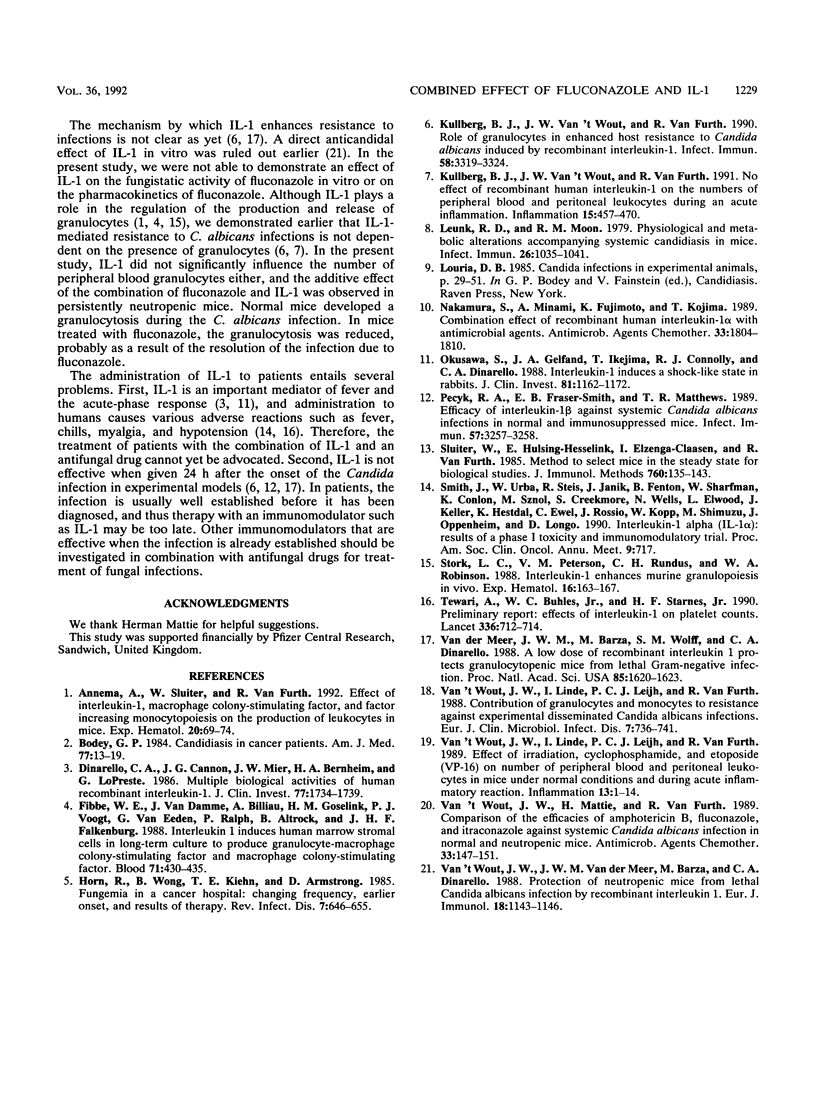Abstract
The aim of the present study was to investigate the efficacy of treatment with a combination of fluconazole and human recombinant interleukin-1 alpha (IL-1 alpha) in normal or neutropenic mice with systemic Candida albicans infection. Six hours after intravenous injection of 5 x 10(4) CFU of C. albicans organisms, oral treatment twice daily with 2.5 or 10 mg of fluconazole per kg of body weight, a single intraperitoneal injection of 80 ng of IL-1, or a combination of the two was started. IL-1 had no influence on the antifungal activity of fluconazole in vitro or on the pharmacokinetics of fluconazole. For both normal and neutropenic mice, the number of C. albicans organisms cultured from the kidneys after 36 h of treatment was significantly lower in mice treated with IL-1 alone than in untreated animals. Treatment with fluconazole alone also significantly lowered the number of C. albicans organisms in the kidneys compared with that in untreated controls. In normal mice, the combination of fluconazole and IL-1 was not better than fluconazole alone. In neutropenic mice, combined treatment with IL-1 and 10 mg of fluconazole per kg led to significantly lower numbers of C. albicans organisms in the kidneys and the spleen than treatment with either agent alone. Although the precise mechanism by which IL-1 enhances resistance to infection is not clear, the additive effect of IL-1 and fluconazole in vivo indicates that combined therapy with immunomodulators and antifungal drugs is beneficial in immunocompromised mice with systemic fungal infections.
Full text
PDF




Selected References
These references are in PubMed. This may not be the complete list of references from this article.
- Annema A., Sluiter W., van Furth R. Effect of interleukin 1, macrophage colony-stimulating factor, and factor increasing monocytopoiesis on the production of leukocytes in mice. Exp Hematol. 1992 Jan;20(1):69–74. [PubMed] [Google Scholar]
- Bodey G. P. Candidiasis in cancer patients. Am J Med. 1984 Oct 30;77(4D):13–19. [PubMed] [Google Scholar]
- Dinarello C. A., Cannon J. G., Mier J. W., Bernheim H. A., LoPreste G., Lynn D. L., Love R. N., Webb A. C., Auron P. E., Reuben R. C. Multiple biological activities of human recombinant interleukin 1. J Clin Invest. 1986 Jun;77(6):1734–1739. doi: 10.1172/JCI112495. [DOI] [PMC free article] [PubMed] [Google Scholar]
- Fibbe W. E., van Damme J., Billiau A., Goselink H. M., Voogt P. J., van Eeden G., Ralph P., Altrock B. W., Falkenburg J. H. Interleukin 1 induces human marrow stromal cells in long-term culture to produce granulocyte colony-stimulating factor and macrophage colony-stimulating factor. Blood. 1988 Feb;71(2):430–435. [PubMed] [Google Scholar]
- Horn R., Wong B., Kiehn T. E., Armstrong D. Fungemia in a cancer hospital: changing frequency, earlier onset, and results of therapy. Rev Infect Dis. 1985 Sep-Oct;7(5):646–655. doi: 10.1093/clinids/7.5.646. [DOI] [PubMed] [Google Scholar]
- Kullberg B. J., Van't Wout J. W., van Furth R. No effect of recombinant human interleukin-1 on numbers of peripheral blood and peritoneal leukocytes during acute inflammation. Inflammation. 1991 Dec;15(6):457–470. doi: 10.1007/BF00923343. [DOI] [PubMed] [Google Scholar]
- Kullberg B. J., van 't Wout J. W., van Furth R. Role of granulocytes in increased host resistance to Candida albicans induced by recombinant interleukin-1. Infect Immun. 1990 Oct;58(10):3319–3324. doi: 10.1128/iai.58.10.3319-3324.1990. [DOI] [PMC free article] [PubMed] [Google Scholar]
- Leunk R. D., Moon R. J. Physiological and metabolic alterations accompanying systemic candidiasis in mice. Infect Immun. 1979 Dec;26(3):1035–1041. doi: 10.1128/iai.26.3.1035-1041.1979. [DOI] [PMC free article] [PubMed] [Google Scholar]
- Nakamura S., Minami A., Fujimoto K., Kojima T. Combination effect of recombinant human interleukin-1 alpha with antimicrobial agents. Antimicrob Agents Chemother. 1989 Oct;33(10):1804–1810. doi: 10.1128/aac.33.10.1804. [DOI] [PMC free article] [PubMed] [Google Scholar]
- Okusawa S., Gelfand J. A., Ikejima T., Connolly R. J., Dinarello C. A. Interleukin 1 induces a shock-like state in rabbits. Synergism with tumor necrosis factor and the effect of cyclooxygenase inhibition. J Clin Invest. 1988 Apr;81(4):1162–1172. doi: 10.1172/JCI113431. [DOI] [PMC free article] [PubMed] [Google Scholar]
- Pecyk R. A., Fraser-Smith E. B., Matthews T. R. Efficacy of interleukin-1 beta against systemic Candida albicans infections in normal and immunosuppressed mice. Infect Immun. 1989 Oct;57(10):3257–3258. doi: 10.1128/iai.57.10.3257-3258.1989. [DOI] [PMC free article] [PubMed] [Google Scholar]
- Sluiter W., Hulsing-Hesselink E., Elzenga-Claasen I., Van Furth R. Method to select mice in the steady state for biological studies. J Immunol Methods. 1985 Jan 21;76(1):135–143. doi: 10.1016/0022-1759(85)90486-7. [DOI] [PubMed] [Google Scholar]
- Stork L. C., Peterson V. M., Rundus C. H., Robinson W. A. Interleukin-1 enhances murine granulopoiesis in vivo. Exp Hematol. 1988 Feb;16(2):163–167. [PubMed] [Google Scholar]
- Tewari A., Buhles W. C., Jr, Starnes H. F., Jr Preliminary report: effects of interleukin-1 on platelet counts. Lancet. 1990 Sep 22;336(8717):712–714. doi: 10.1016/0140-6736(90)92206-w. [DOI] [PubMed] [Google Scholar]
- Van t Wout J. W., Mattie H., van Furth R. Comparison of the efficacies of amphotericin B, fluconazole, and itraconazole against a systemic Candida albicans infection in normal and neutropenic mice. Antimicrob Agents Chemother. 1989 Feb;33(2):147–151. doi: 10.1128/aac.33.2.147. [DOI] [PMC free article] [PubMed] [Google Scholar]
- Van't Wout J. W., Van der Meer J. W., Barza M., Dinarello C. A. Protection of neutropenic mice from lethal Candida albicans infection by recombinant interleukin 1. Eur J Immunol. 1988 Jul;18(7):1143–1146. doi: 10.1002/eji.1830180728. [DOI] [PubMed] [Google Scholar]
- van 't Wout J. W., Linde I., Leijh P. C., van Furth R. Contribution of granulocytes and monocytes to resistance against experimental disseminated Candida albicans infection. Eur J Clin Microbiol Infect Dis. 1988 Dec;7(6):736–741. doi: 10.1007/BF01975039. [DOI] [PubMed] [Google Scholar]
- van der Meer J. W., Barza M., Wolff S. M., Dinarello C. A. A low dose of recombinant interleukin 1 protects granulocytopenic mice from lethal gram-negative infection. Proc Natl Acad Sci U S A. 1988 Mar;85(5):1620–1623. doi: 10.1073/pnas.85.5.1620. [DOI] [PMC free article] [PubMed] [Google Scholar]
- van't Wout J. W., Linde I., Leijh P. C., van Furth R. Effect of irradiation, cyclophosphamide, and etoposide (VP-16) on number of peripheral blood and peritoneal leukocytes in mice under normal conditions and during acute inflammatory reaction. Inflammation. 1989 Feb;13(1):1–14. doi: 10.1007/BF00918959. [DOI] [PubMed] [Google Scholar]


